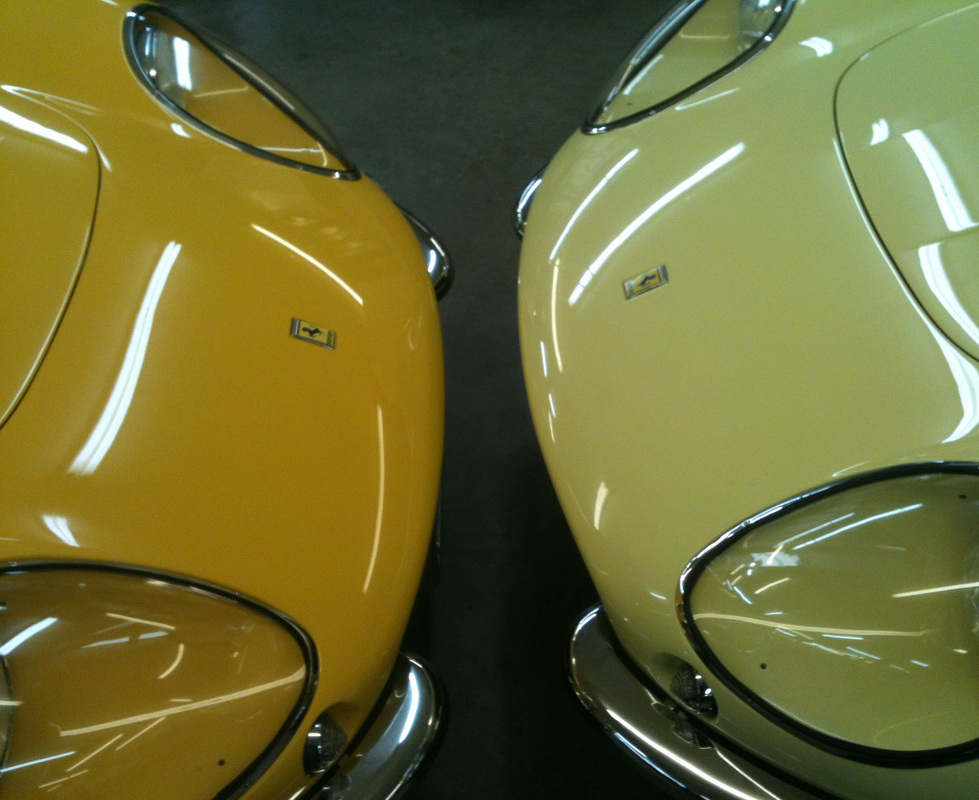|
For a year and a half I worked as a chrome specialist at a shop specializing in complete restorations of vintage exotic automobiles. This is some of what I learned. Owners would bring in ultra-rare or extra-special cars and we would put everything back to the specifications of the factory, down to the paint on the back of the dash. I gained intimate knowledge of some of the most elusive and sought-after cars in the world – 300 SL Gullwings, 275 GTB four-cams, Bugattis from the 30's, California Spiders and Testa-Rossas among them. It was like working in a museum of exotic automotive history, only I got to fondle the exhibits. I got to crawl in, out and all over cars that are the pipe dreams of regular folk. It was glorious … most of the time. For a year and a half I worked as a chrome specialist at a shop specializing in complete restorations of vintage exotic automobiles. This is some of what I learned. Owners would bring in ultra-rare or extra-special cars and we would put everything back to the specifications of the factory, down to the paint on the back of the dash. I gained intimate knowledge of some of the most elusive and sought-after cars in the world – 300 SL Gullwings, 275 GTB four-cams, Bugattis from the 30's, California Spiders and Testa-Rossas among them. 6. Different Standards Everything had to be spot on; in fact, it had to be better than factory. These cars left our shop much nicer than Ferrari or Bugatti ever intended them to be. There were budgets and deadlines to be met at the factories that produced these cars. At the shop, though, the emphasis was on doing a flawless job no matter how long it took. The shop kept different hours than most businesses because owners of ultra-rare exotics for the most part are not walk-in customers. The cars came in on transport trucks from all over the nation and abroad. There was this one guy who would drive in his 330 Ferrari, but more on him later. 5. Price Scale What goes into creating the car you see going on the auction block for seven figures? Work, lots of it, and lots of research too. When playing the car game at this level it pays to do you due diligence. Winning or getting a near perfect score at the big shows is a way of certifying how nice a car really is. I was talking to a co-worker who told me a story of showing a car at the Pebble Beach Concours D'elegance. The car was stunning, everything was spot on down to the correct time of day on the dash clock. However when the judges came by one of them noted that the second hand was doing stop-start tick-tock movement rather than the smooth movement of the clock on original cars. This made the car a couple points shy of a perfect score. The judge had done his homework, the guy that rebuilt the clock had not. From then on dash clocks were outsourced to a different company The owners of these cars could buy a new Ferrari for what these things cost to restore. But the rarity and history connected with these cars makes it worthwhile. As that new Ferrari suffers devastating depreciation, restoring one of these offers a return on the investment come auction time. EVERYTHING becomes extraordinarily expensive when you enter this realm of automobiles. 4. Clientele Working with such high-priced machinery, you expect the Monopoly guy to stroll in swinging a cane, casting better-than-thou glances through his monocle at the lowly proles slaving away on his car. But I never felt that icy vibe off any of the clients. Most of them were successful entrepreneurs who happened to also be car guys… and let's face it, if we had the bankroll, who wouldn't lay down the cash for their favorite car? There's a stereotype that these guys are all big-money jerks grabbing up the vintage stuff and driving up prices. But it's really more of a supply and demand situation with the rarest, whether because there were limited numbers to begin with or something historical happened to it, going for the most money. There just aren't enough '58 250 Testa Rossas to go around. My favorite owner ran what amounts to a giant flea market. He was a self-made man and wore a smile every time I saw him. He'd roll up in his unwashed 1960's 330 and throw his foot up on the front bumper and tie his shoe. "Shoot, I just don't know how you boys get 'em lookin' so shiny." I loved working on this guy's car. It was an older restoration and it wasn't a show queen. It was taken out and driven hard and often. On the console of this little red car, in front of the gated shifter, were all his rally pins stuck right onto his gorgeous black upholstery. Right there, in full, unabashed view, purists be damned and to hell with what others thought. He drove his six-figure car not caring about the miles it racked up or mollycoddling it. It was refreshing that, among all these pristine show cars there was at least one that still got to turn its tires in anger on public roadways. 3. Etiquette There's a certain code of behavior when working around these machines. Every car was covered every day with disposable car covers. If a customer was coming, everything in the already tidy shop was tidied further. All the cars were uncovered and cleaned and a deep sweep of the shop was standard procedure. One thing I learned was to NEVER lean a broom up ANYWHERE. It could fall and ding a car. When shop rates are astronomical, any little ding or chip turns into big money. What's worse is when this sort of thing happens when preparing for a show; it adds one more to-do to an already hectic schedule. Many of these cars had knock-off wheels, with a big nut in the middle, rather than multiple lug nuts, that is tightened by hitting it with a big lead hammer. The first one of these wheels I had to take off was on a million-dollar show car headed to Pebble Beach with paint so fresh you could still smell it painted. My hand trembled around the handle of the hammer and the first few blows I landed were so soft that they had no chance of loosening anything. But eventually you get used to it and don't think twice. In fact some days you take sick pleasure in swinging a hammer the damn things. 2. It's Just A Car After rubbing elbows with these things day in day out the just become old cars to you. I did the same job no matter what. Whether I was working on the irreplaceable radiator shroud from a1930's Mercedes or a bumper of a Super Beetle (which would cost more than the car is worth to have it chromed in this shop), I took the same steps toward flawless chrome. At one point we had half a dozen 275 GTBs in the shop. Some were in for routine maintenance, some were being prepped for a show and one was being examined for the would-be purchaser to see if it was a good candidate for restoration. There were two California Spiders in the shop at one time. There was always a menagerie of 330s and 275s coming in and out. Exposure to these cars makes them seem less rare and elusive. You almost expect to see one on the drive home. 1. Craftsmanship Whether it was building engines, creating upholstery, bodywork and paint, or just detail and assembly, these guys were all committed to making everything perfect and as close as humanly possible to what came from the factory. There's one way to stay afloat and relevant in vintage exotic restoration, and that's to hire craftsmen who are willing to do the type of work that yields results at shows like Pebble Beach. A popular way of thinking of these cars is that rich guys buy them and sell them to one another and the money is just passed around between them, and us ordinary folks are never allowed a taste of either of them. While that's what it looks like from the outside the truth is that the owners pay for these things every step of the way. Yea, there's an initial purchase price, but that's only the beginning. They must be transported, there's a guy for that. They must be restored, rebuilt, repainted and maintained. There are guys for that. The point is that there are guys all along the way that make a living keeping these cars alive, not just rich guys passing money and rare cars around. Do I miss going to work every day and seeing exotic, sexy cars and having the privilege of saying I work on Ferraris? You bet. Do I worry sometimes that I might never have a cooler job? Sure, but then I remember what it's like to block sand chrome by hand for ten hours a day. Even though I loved the cars, most aspects of my job and didn't mind the work I wanted more from my career. Many of the guys I worked with have worked there over twenty years. All the bases were covered at this shop and there wasn't a great need for anything other than block sanding chrome. When I looked into my future there I saw an endless line of old rusty bumpers and pieces of trim that needed to be made new again. I made a choice to leave the shop for a soul-sucking, boring, beige, vanilla desk job writing bond proposals at a bank. I only lasted for three months before I realized what I wanted to do with myself. I was reading some article online about cars, surprise, and thought "how cool would it be to do this as a job?" My next thought was "why not me?" I quit the next week. Pen in hand, I went back to school and back to restoration work.
You can read more articles like this on AaronStarnes.com and follow me at @AaronVStarnes
1 Comment
Hi Aaron,
Reply
Leave a Reply. |
Cars and CarsThis is a space for coverage of car shows, feature cars, and clumsily stumble through the rigors of learning to shoot photos. CatagoriesClick 'add a comment' after any post and leave some feedback.
Never miss an update Follow me on Twitter @AaronVStarnes Archives
August 2014
|










 RSS Feed
RSS Feed
